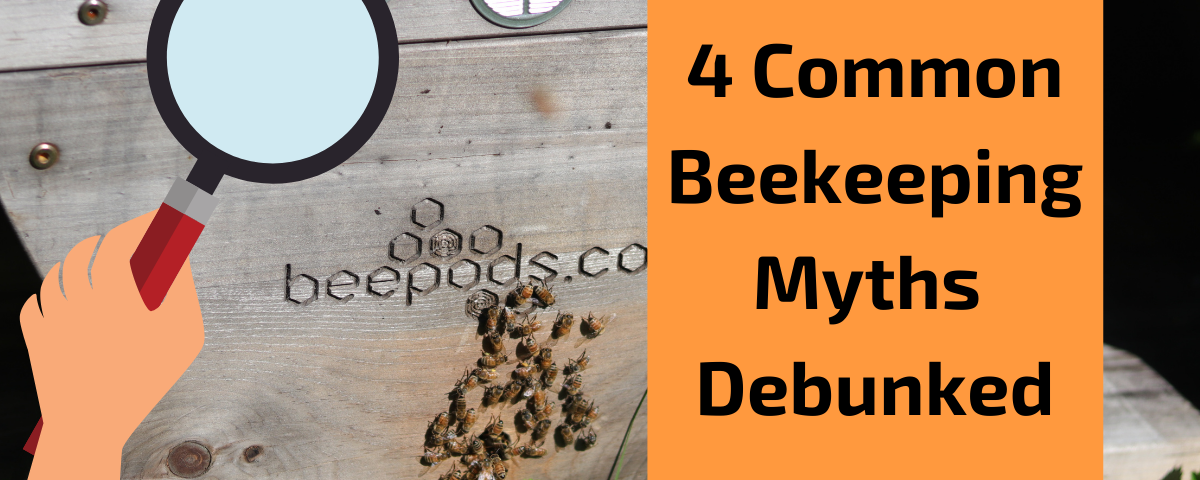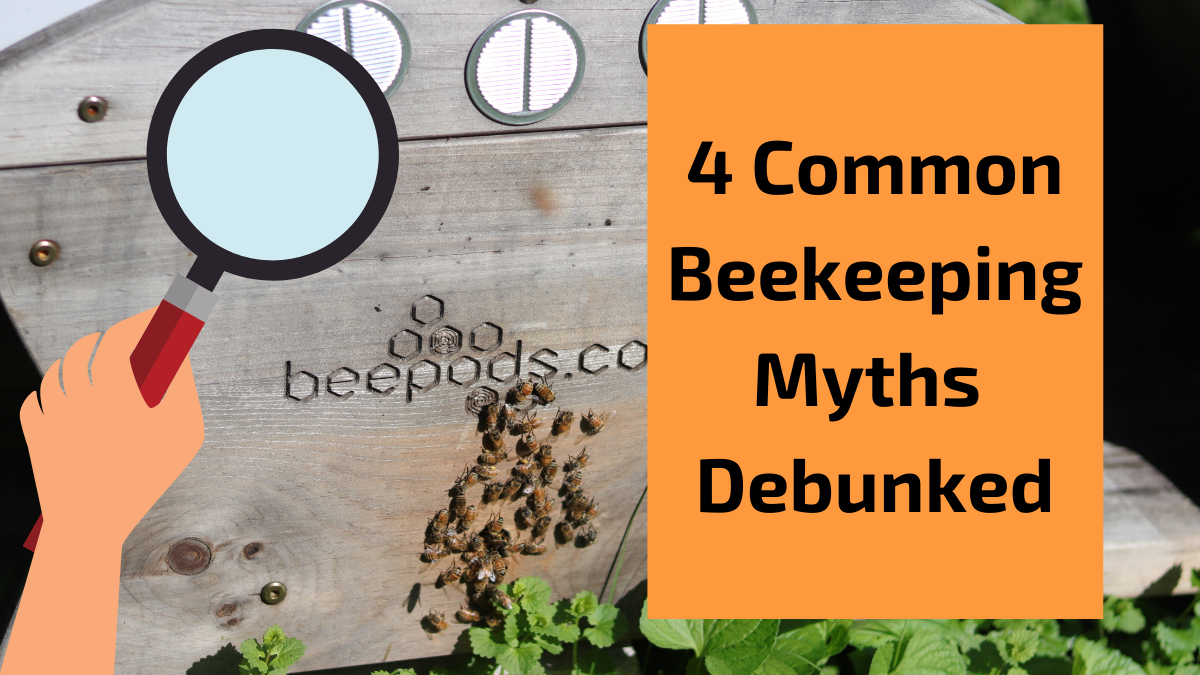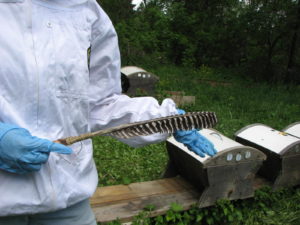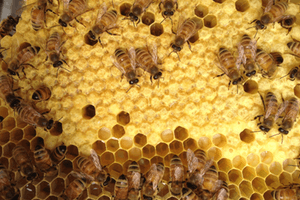- All-In-One Beekeeping for the Bees
- +1-608-728-8233
- info@beepods.com
4 Common Beekeeping Myths Debunked

 As more of us are spending unprecedented amounts of time at home and exploring new interests and activities, beekeeping is continuing to grow in popularity. But on occasion, an eager new beekeeper is dissuaded by their perceptions of it being an intimidating hobby or one they can’t learn on their own. Fear not! Today, we’re putting four common beekeeping myths to rest. If you’ve had concerns or worries about getting started with beekeeping, this post will put you at ease. Let’s dive in!
As more of us are spending unprecedented amounts of time at home and exploring new interests and activities, beekeeping is continuing to grow in popularity. But on occasion, an eager new beekeeper is dissuaded by their perceptions of it being an intimidating hobby or one they can’t learn on their own. Fear not! Today, we’re putting four common beekeeping myths to rest. If you’ve had concerns or worries about getting started with beekeeping, this post will put you at ease. Let’s dive in!
I Need a Large and Rural Property

Beepod on the roof of Core El Centro
One beekeeping myth we hear a lot is that you need to have acres of farm-like property to start a beehive. The truth is, you can set up a beehive just about anywhere.
As long as you can create a level foundation, have access to sunlight, and are within several miles of quality forage, you can have bees! The rise of urban gardening has made it more possible than ever for beekeepers in both city and rural settings to maintain a healthy and productive hive.
Beepods are ideally suited to patios, rooftops, and backyards alike. And as long as your city or county allows bees, there’s no need for an expansive property or farm. Check out our Bee Yard Setup and Siting Blueprint for the rundown on everything you need to ensure your hive will thrive and survive!
I’m Going to Get Stung Constantly
The fear of stings is enough to make an otherwise excited new beekeeper nervous. We get it. It’s not like getting stung is enjoyable! However, constant stinging is one of those beekeeping myths that just isn’t true.
At Beepods, we’re committed to beekeeping for the bees, and treating bees as we want to be treated is an underlying principle in how we approach beekeeping. From our top bar hives, which are less disruptive to your bees, to our bee-friendly approaches and techniques, we make every effort to help our bees remain calm and unbothered. In turn, we find that bees aren’t too aggravated by their beekeepers, and thus, are less likely to act defensively and sting.
Our members’ area, Beepods Lab, has helpful resources and tips on how to work with your bees considerately. In Lab, you’ll also find The Beekeeper’s Mindset Execution Plan, which will help you get yourself in the right frame of mind to stay focused and relaxed around your bees.
It Will Take a Lot of My Time

One of our beekeepers using the tool to scrape comb.
Beekeeping is a hobby that will require some of your free time, but the myth that you’ll spend every waking hour at your hive simply isn’t true. Yes, siting and setting up your hive as you get started will require several hours out of your schedule. Investing time in learning about beekeeping from mentors, friends, or virtually will also be essential to your hive’s success.
But once you get going, you’ll learn there is a reasonably expectable frequency to your hive inspections and maintenance throughout the year. In the spring, for example, beekeepers should anticipate spending 15-40 minutes tending to their hive every two weeks to prepare their bees for the months ahead. Alternatively, in the summer and fall, you can expect to spend closer to 90 minutes every two weeks since there is much more to do during your bees’ “busy” season.
Once you decide to start beekeeping, subscribing to Beepods’ Honey Do Monthly Beekeeping Checklists will help you stay on top of your beekeeping tasks and responsibilities. Each month, you receive our checklist covering everything you need to do to help your hive be healthy and productive. Armed with the knowledge of what to expect every month, you’ll be prepared to plan your schedule and set aside the time you need for your bees.
I Need to Invest in Lots of Tools and Equipment
For new beekeepers, figuring out precisely what equipment you need to not only take care of your bees, but to be as efficient and productive as possible at the hive can be daunting. But the idea that you need to buy a ton of different tools and equipment is a myth.

A beekeeper uses a Feather Guider to help them work around the hive.
In reality, you need several critical pieces of equipment to carry out your work around the hive and with your bees. However, purchasing the right tools and equipment upfront will save you from trial and error, wasting your money, and more importantly, wasting time that you could spend completing your handy Honey Do checklists every month!
The Beepods Complete Beekeeping System comes with all of the tools and equipment you need to start beekeeping. From the Beepod Vented Top Bar Hive and Inspection Kit to your Feather Guider and Jacket Veil, the system has all that you need to hit the ground running.
Plus, the system comes with a one-year membership to Beepods Lab, where there are countless videos and information available to help you understand the best techniques for using your tools and equipment. You get everything necessary to set your hive up for success!
Closing Thoughts
Beekeeping is certainly a hobby that requires dedication. But it’s absolutely one that can be started by anyone committed to caring for their bees, supporting pollinators, and doing their part to create a more sustainable planet. We hope this post dispelled the common beekeeping myths that may have been stopping you from getting started! And if you’re ready, Beepods is here to help you along the way!
Kanoe Riedel
Latest posts by Kanoe Riedel (see all)
- This Spring, Don’t Forget Why Bees Are So Important to Our Environment - March 26, 2021
- 11 Awesome Uses for Your Stored Honeycomb - March 2, 2021
- How the Right Beekeeping Equipment Makes Inspections Better for Beekeepers and Bees - February 12, 2021



